engine SKODA SUPERB 2004 1.G / (B5/3U) Workshop Manual
[x] Cancel search | Manufacturer: SKODA, Model Year: 2004, Model line: SUPERB, Model: SKODA SUPERB 2004 1.G / (B5/3U)Pages: 270
Page 189 of 270

Driving and the Environment
188
Avoid driving short distances
Short distances result in an above-average high fuel
consumption.
– Avoid driving a distance of no more than 4 km if the engine is
cold.
The engine and catalytic converter must first have reached their optimal
operating temperature in order to effectively reduce fuel consumption
and pollutant emissions.
The cold engine vehicle consumes approx. 20 - 30 litres/100 km of fuel
immediately after starting. Fuel consumption drops to 15 litres/100 km
after just 1 kilometre. The engine reaches its operating temperature
(outside temperature and engine dependent) only after about 4 to 10 kilo-
metres and the fuel consumption then stabilizes. You should therefore
avoid driving short distances whenever possible. An important factor in this connection is also the
ambient temperature.
The ⇒fig. 154 shows the different fuel consumptions for the same
distance, on the one hand at +20°C and on the other hand at -10°C. Your
vehicle has a higher fuel consumption in winter than in summer.
Checking tyre inflation pressures
Tyres which are correctly inflated save fuel.
Always ensure that your tyres are inflated to the correct pressure at all
times. The rolling resistance will be increased if the tyre filling pressure is
too low. This will not only increase fuel consumption but also tyre wear
and the driving behaviour will worsen.
Always check the inflation pressure of the tyres when cold.
Do not drive with winter tyres all year round for this costs about 10 %
more fuel. Winter tyres are also louder.
No unnecessary ballast
Transporting ballast costs fuel.
The fact that every kilogram of extra weight increases your fuel consump-
tion means that it is worth taking a look in the luggage compartment to
avoid transporting any unnecessary ballast.
It is particularly in town trafffic, when one is accelerating quite often, that
the vehicle weight will have a significant effect upon the fuel consumption.
A rule of thumb here is that an increase in weight of 100 kilograms will
cause an increase in fuel consumption of about 1 litre/100 kilometres.
You may frequently also leave a roof rack fitted on just out of conven-
ience, although you no longer need it. The increased aerodynamic drag of
Fig. 154 Fuel
consumption in
litres/100 km at
different temperatures
Page 190 of 270

Driving and the Environment189
Using the systemSafetyDriving TipsGeneral MaintenanceBreakdown assistanceTechnical Data
your vehicle causes it to use about 1 l more fuel than normal at a speed
of 100 - 120 km/h, even when you are not carrying a load on the roof.
Saving electricity
Generating electricity costs fuel.
– Switch off electrical components as soon as you no longer
need them.
When the engine is running, the alternator generates and supplies elec-
trical power. The greater the load on the alternator as a result of having a
large number of electrical components switched on, the more fuel will be
consumed for operating the alternator.
Keeping a log of your fuel consumption
If you really wish to keep a close check on your fuel consumption, it is
best to enter the figures in a logbook. This does not take much time but is
a very worthwhile exercise. It enables you to detect any change (positive
and negative) at an early stage and to take any appropriate action.
If you find that your fuel consumption is too high, you should reflect on
how, where and in what conditions you have driven the vehicle since you
last refuelled.
Environmental compatibility
Environmental protection has played a major role in the design, selection
of materials and manufacture of your new Škoda. Particular emphasis has
been paid to a number of aspects, including:
Design measures
•Joints designed to be easily detached
•Simplified disassembly due to the modular structure system
•Improved purity of different classes of materials
•Identification of all plastic parts in accordance with VDA Recommen-
dation 260
•Reduced fuel consumption and exhaust emission CO2
•Minimum fuel leakage during accidents
•Reduced noise
Choice of materials
•Extensive use of recyclable material
•Air conditioning filled with CFC-free refrigerant
•No cadmium
•No asbestos
•Reduction in the “vaporisation” of plastics
Manufacture
•Solvent-free cavity protection
•Solvent-free protection of the vehicle for transportation from the
production plant to the customer
•Use of solvent-free adhesives
•No CFCs used in the production process
•Without use of mercury
•Use of water-soluble paints
Page 191 of 270
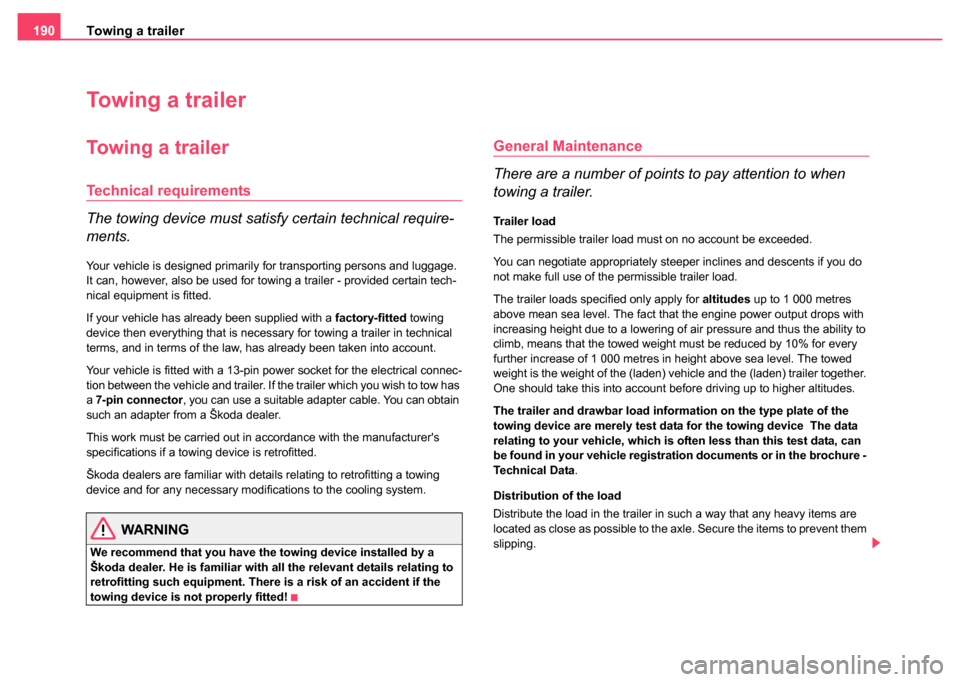
Towing a trailer
190
Towing a trailer
Towing a trailer
Technical requirements
The towing device must satisfy certain technical require-
ments.
Your vehicle is designed primarily for transporting persons and luggage.
It can, however, also be used for towing a trailer - provided certain tech-
nical equipment is fitted.
If your vehicle has already been supplied with a factory-fitted towing
device then everything that is necessary for towing a trailer in technical
terms, and in terms of the law, has already been taken into account.
Your vehicle is fitted with a 13-pin power socket for the electrical connec-
tion between the vehicle and trailer. If the trailer which you wish to tow has
a 7-pin connector , you can use a suitable adapter cable. You can obtain
such an adapter from a Škoda dealer.
This work must be carried out in accordance with the manufacturer's
specifications if a towing device is retrofitted.
Škoda dealers are familiar with details relating to retrofitting a towing
device and for any necessary modifications to the cooling system.
WARNING
We recommend that you have the towing device installed by a
Škoda dealer. He is familiar with all the relevant details relating to
retrofitting such equipment. There is a risk of an accident if the
towing device is not properly fitted!
General Maintenance
There are a number of points to pay attention to when
towing a trailer.
Trailer load
The permissible trailer load must on no account be exceeded.
You can negotiate appropriately steeper inclines and descents if you do
not make full use of the permissible trailer load.
The trailer loads specified only apply for altitudes up to 1 000 metres
above mean sea level. The fact that the engine power output drops with
increasing height due to a lowering of air pressure and thus the ability to
climb, means that the towed weight must be reduced by 10% for every
further increase of 1 000 metres in height above sea level. The towed
weight is the weight of the (laden) vehicle and the (laden) trailer together.
One should take this into account before driving up to higher altitudes.
The trailer and drawbar load information on the type plate of the
towing device are merely test data for the towing device The data
relating to your vehicle, which is often less than this test data, can
be found in your vehicle registration documents or in the brochure -
Technical Data .
Distribution of the load
Distribute the load in the trailer in such a way that any heavy items are
located as close as possible to the axle. Secure the items to prevent them
slipping.
Page 193 of 270
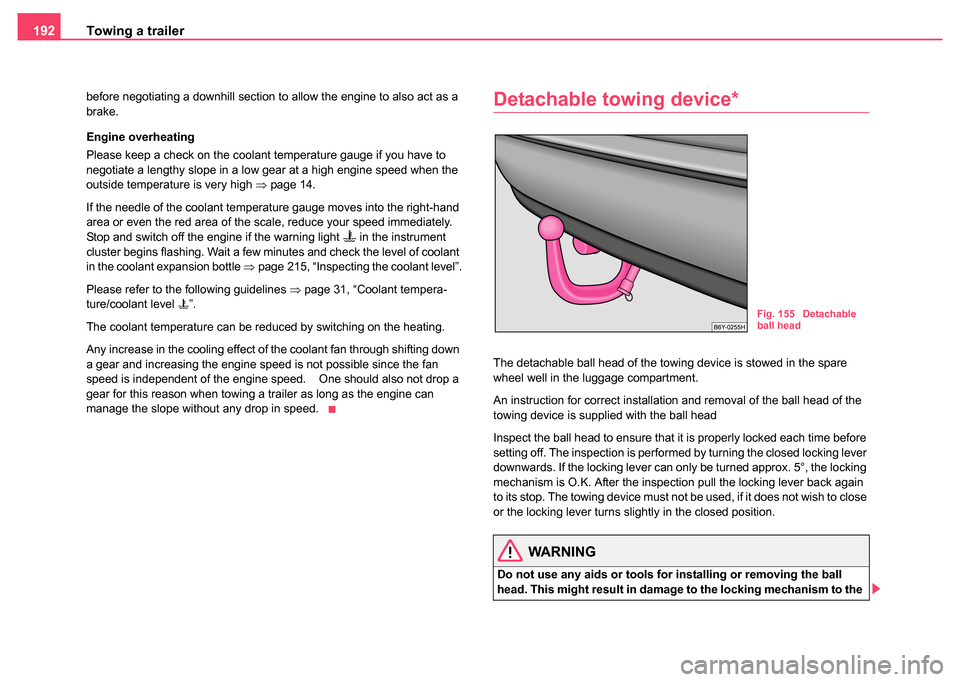
Towing a trailer
192
before negotiating a downhill section to allow the engine to also act as a
brake.
Engine overheating
Please keep a check on the coolant temperature gauge if you have to
negotiate a lengthy slope in a low gear at a high engine speed when the
outside temperature is very high ⇒page 14.
If the needle of the coolant temperature gauge moves into the right-hand
area or even the red area of the scale, reduce your speed immediately.
Stop and switch off the engine if the warning light
in the instrument
cluster begins flashing. Wait a few minutes and check the level of coolant
in the coolant expansion bottle ⇒page 215, “Inspecting the coolant level”.
Please refer to the following guidelines ⇒page 31, “Coolant tempera-
ture/coolant level ”.
The coolant temperature can be reduced by switching on the heating.
Any increase in the cooling effect of the coolant fan through shifting down
a gear and increasing the engine speed is not possible since the fan
speed is independent of the engine speed. One should also not drop a
gear for this reason when towing a trailer as long as the engine can
manage the slope without any drop in speed.
Detachable towing device*
The detachable ball head of the towing device is stowed in the spare
wheel well in the luggage compartment.
An instruction for correct installation and removal of the ball head of the
towing device is supplied with the ball head
Inspect the ball head to ensure that it is properly locked each time before
setting off. The inspection is performed by turning the closed locking lever
downwards. If the locking lever can only be turned approx. 5°, the locking
mechanism is O.K. After the inspection pull the locking lever back again
to its stop. The towing device must not be used, if it does not wish to close
or the locking lever turns slightly in the closed position.
WARNING
Do not use any aids or tools for installing or removing the ball
head. This might result in damage to the locking mechanism to the
Fig. 155 Detachable
ball head
Page 201 of 270

Care and cleaning
200
WARNING
One should remember when cleaning the wheels that moisture, ice
and road salt may adversely affect braking efficiency - risk of an
accident!
Note
Severe layers of dirt on the wheels can also result in wheel imbalance.
This may show itself in the form of wheel vibration which is transmitted to
the steering wheel which, in certain circumstances, can cause premature
wear of the steering. It is therefore important to clean dirty wheels.
Underbody protection
The underside of your vehicle is protected for life against chemical and
mechanical influences.
One cannot, however, completely rule out damage to the protective layer
when driving so we recommend that you inspect the protective layer on
the underside of your vehicle and on the chassis at certain intervals - this
is best done at the beginning and end of the winter - and to touch up any
damaged areas.
Škoda dealers have suitable spray products available as well as the
necessary equipment and are familiar with the instructions for its use. It is
therefore best to have such touch-up work or additional corrosion protec-
tion measures carried out by a Škoda dealer.
WARNING
Never use additional underbody protection or corrosion-protection
agents for the exhaust pipes, catalytic converters or heat shields.
Such substances might ignite when driving - risk of fire!
Protection of hollow spaces
All the cavities of your vehicle which are at risk from corrosion are
protected for life by a layer of protective wax applied in the factory.
This wax protection does not require to be inspected or re-treated. Please
remove any small amount of wax which flows out of the cavities at high
temperatures with a plastic scraper and clean the spot using petroleum
cleaner.
WARNING
Safety and environmental protection regulations should observed
when using petroleum cleaner to remove wax - a risk of fire!
Engine compartment
Good corrosion protection is very important, particularly in winter when
one often drives over its salt-strewn roads. One should therefore clean the
whole engine compartment and the radiator tank before and after the salt
spreading period and treat with preservative in order to prevent the salt
from being destructive.
Škoda dealers have the cleaning agents and preservatives recommended
by the manufacturer and also the required equipment.
WARNING
•It is necessary to observe the guidelines given in the chapter
before working on the engine compartment ⇒page 209.
•Let the engine cool down before cleaning the engine compart-
ment.
Page 202 of 270
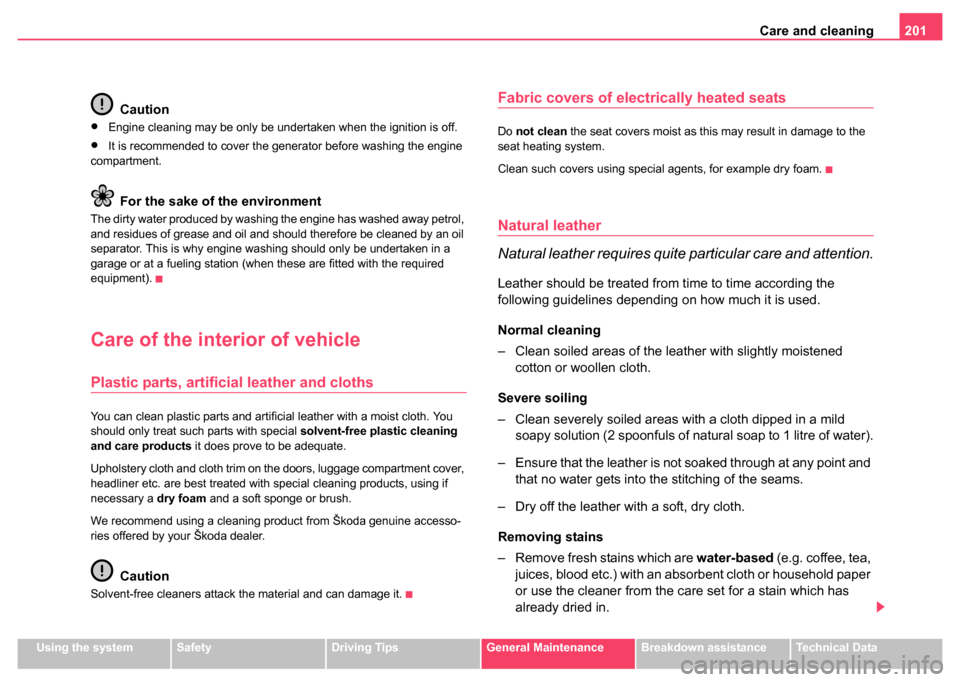
Care and cleaning201
Using the systemSafetyDriving TipsGeneral MaintenanceBreakdown assistanceTechnical Data
Caution
•Engine cleaning may be only be undertaken when the ignition is off.
•It is recommended to cover the generator before washing the engine
compartment.
For the sake of the environment
The dirty water produced by washing the engine has washed away petrol,
and residues of grease and oil and should therefore be cleaned by an oil
separator. This is why engine washing should only be undertaken in a
garage or at a fueling station (when these are fitted with the required
equipment).
Care of the interior of vehicle
Plastic parts, artificial leather and cloths
You can clean plastic parts and artificial leather with a moist cloth. You
should only treat such parts with special solvent-free plastic cleaning
and care products it does prove to be adequate.
Upholstery cloth and cloth trim on the doors, luggage compartment cover,
headliner etc. are best treated with special cleaning products, using if
necessary a dry foam and a soft sponge or brush.
We recommend using a cleaning product from Škoda genuine accesso-
ries offered by your Škoda dealer.
Caution
Solvent-free cleaners attack the material and can damage it.
Fabric covers of electrically heated seats
Do not clean the seat covers moist as this may result in damage to the
seat heating system.
Clean such covers using special agents, for example dry foam.
Natural leather
Natural leather requires quite particular care and attention.
Leather should be treated from time to time according the
following guidelines depending on how much it is used.
Normal cleaning
– Clean soiled areas of the leather with slightly moistened cotton or woollen cloth.
Severe soiling
– Clean severely soiled areas with a cloth dipped in a mild soapy solution (2 spoonfuls of natural soap to 1 litre of water).
– Ensure that the leather is not soaked through at any point and that no water gets into the stitching of the seams.
– Dry off the leather with a soft, dry cloth.
Removing stains
– Remove fresh stains which are water-based (e.g. coffee, tea,
juices, blood etc.) with an absorbent cloth or household paper
or use the cleaner from the care set for a stain which has
already dried in.
Page 205 of 270
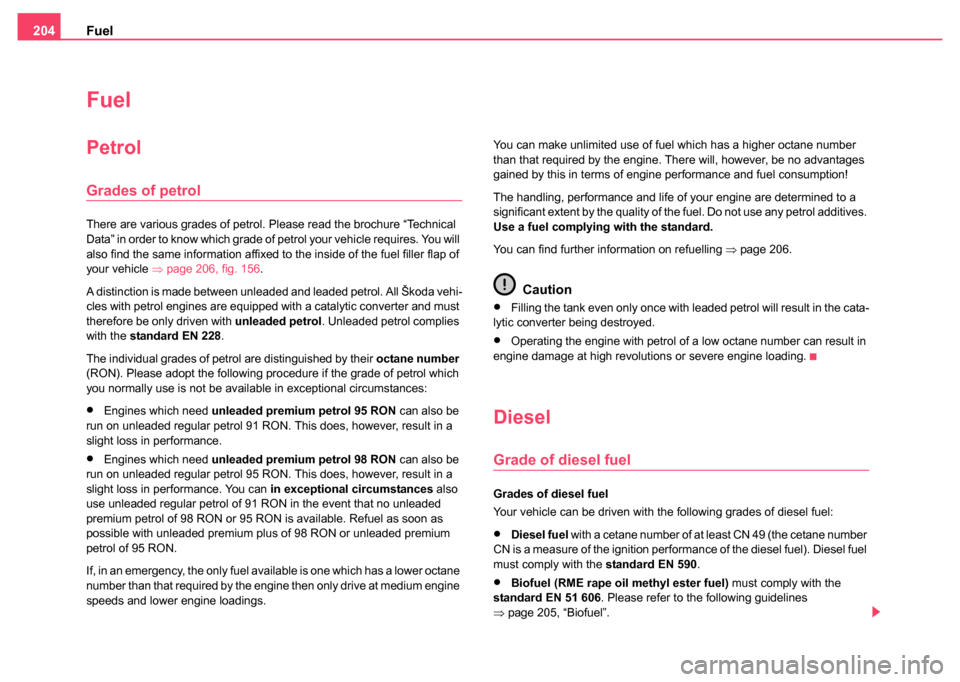
Fuel
204
Fuel
Petrol
Grades of petrol
There are various grades of petrol. Please read the brochure “Technical
Data” in order to know which grade of petrol your vehicle requires. You will
also find the same information affixed to the inside of the fuel filler flap of
your vehicle ⇒page 206, fig. 156 .
A distinction is made between unleaded and leaded petrol. All Škoda vehi-
cles with petrol engines are equipped with a catalytic converter and must
therefore be only driven with unleaded petrol. Unleaded petrol complies
with the standard EN 228 .
The individual grades of petrol are distinguished by their octane number
(RON). Please adopt the following procedure if the grade of petrol which
you normally use is not be available in exceptional circumstances:
•Engines which need unleaded premium petrol 95 RON can also be
run on unleaded regular petrol 91 RON. This does, however, result in a
slight loss in performance.
•Engines which need unleaded premium petrol 98 RON can also be
run on unleaded regular petrol 95 RON. This does, however, result in a
slight loss in performance. You can in exceptional circumstances also
use unleaded regular petrol of 91 RON in the event that no unleaded
premium petrol of 98 RON or 95 RON is available. Refuel as soon as
possible with unleaded premium plus of 98 RON or unleaded premium
petrol of 95 RON.
If, in an emergency, the only fuel available is one which has a lower octane
number than that required by the engine then only drive at medium engine
speeds and lower engine loadings. You can make unlimited use of fuel which has a higher octane number
than that required by the engine. There will, however, be no advantages
gained by this in terms of engine performance and fuel consumption!
The handling, performance and life of your engine are determined to a
significant extent by the quality of the fuel. Do not use any petrol additives.
Use a fuel complying with the standard.
You can find further information on refuelling
⇒page 206.
Caution
•Filling the tank even only once with leaded petrol will result in the cata-
lytic converter being destroyed.
•Operating the engine with petrol of a low octane number can result in
engine damage at high revolutions or severe engine loading.
Diesel
Grade of diesel fuel
Grades of diesel fuel
Your vehicle can be driven with the following grades of diesel fuel:
•Diesel fuel with a cetane number of at least CN 49 (the cetane number
CN is a measure of the ignition performance of the diesel fuel). Diesel fuel
must comply with the standard EN 590.
•Biofuel (RME rape oil methyl ester fuel) must comply with the
standard EN 51 606 . Please refer to the following guidelines
⇒ page 205, “Biofuel”.
Page 206 of 270
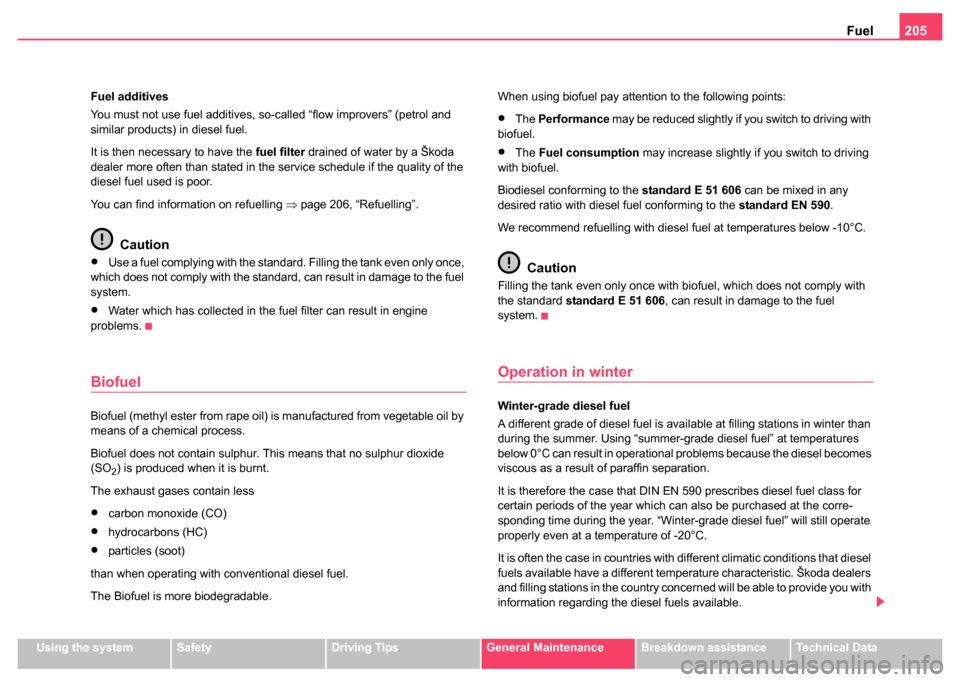
Fuel205
Using the systemSafetyDriving TipsGeneral MaintenanceBreakdown assistanceTechnical Data
Fuel additives
You must not use fuel additives, so-called “flow improvers” (petrol and
similar products) in diesel fuel.
It is then necessary to have the
fuel filter drained of water by a Škoda
dealer more often than stated in the service schedule if the quality of the
diesel fuel used is poor.
You can find information on refuelling ⇒page 206, “Refuelling”.
Caution
•Use a fuel complying with the standard. Filling the tank even only once,
which does not comply with the standard, can result in damage to the fuel
system.
•Water which has collected in the fuel filter can result in engine
problems.
Biofuel
Biofuel (methyl ester from rape oil) is manufactured from vegetable oil by
means of a chemical process.
Biofuel does not contain sulphur. This means that no sulphur dioxide
(SO
2) is produced when it is burnt.
The exhaust gases contain less
•carbon monoxide (CO)
•hydrocarbons (HC)
•particles (soot)
than when operating with conventional diesel fuel.
The Biofuel is more biodegradable. When using biofuel pay attention to the following points:
•The
Performance may be reduced slightly if you switch to driving with
biofuel.
•The Fuel consumption may increase slightly if you switch to driving
with biofuel.
Biodiesel conforming to the standard E 51 606 can be mixed in any
desired ratio with diesel fuel conforming to the standard EN 590.
We recommend refuelling with diesel fuel at temperatures below -10°C.
Caution
Filling the tank even only once with biofuel, which does not comply with
the standard standard E 51 606 , can result in damage to the fuel
system.
Operation in winter
Winter-grade diesel fuel
A different grade of diesel fuel is available at filling stations in winter than
during the summer. Using “summer-grade diesel fuel” at temperatures
below 0°C can result in operational problems because the diesel becomes
viscous as a result of paraffin separation.
It is therefore the case that DIN EN 590 prescribes diesel fuel class for
certain periods of the year which can also be purchased at the corre-
sponding time during the year. “Winter-grade diesel fuel” will still operate
properly even at a temperature of -20°C.
It is often the case in countries with different climatic conditions that diesel
fuels available have a different temperature characteristic. Škoda dealers
and filling stations in the country concerned will be able to provide you with
information regarding the diesel fuels available.
Page 208 of 270
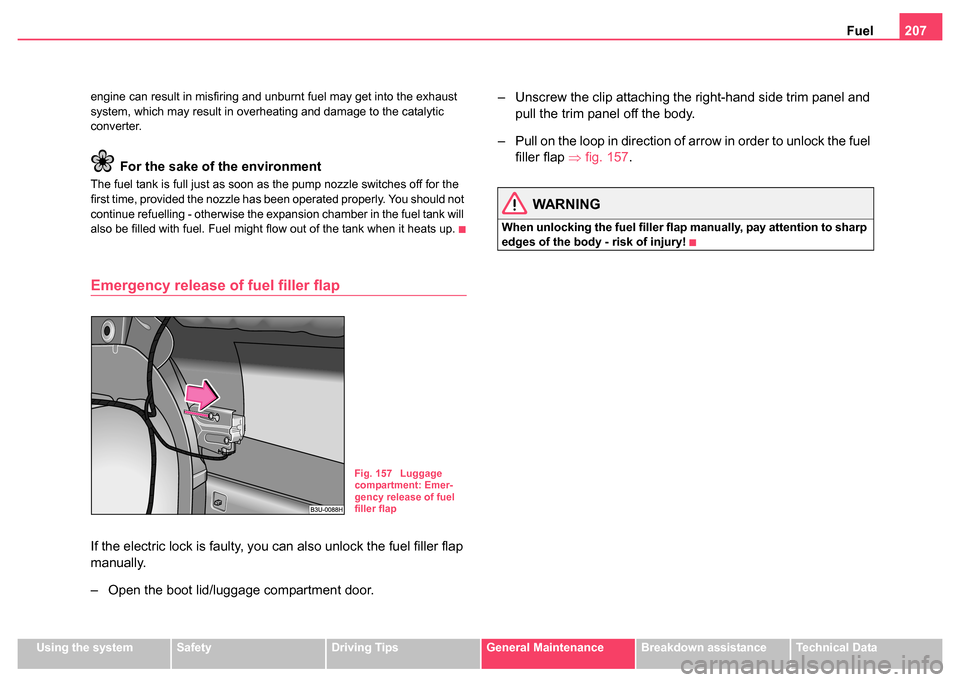
Fuel207
Using the systemSafetyDriving TipsGeneral MaintenanceBreakdown assistanceTechnical Data
engine can result in misfiring and unburnt fuel may get into the exhaust
system, which may result in overheating and damage to the catalytic
converter.
For the sake of
the environment
The fuel tank is full just as soon as the pump nozzle switches off for the
first time, provided the nozzle has been operated properly. You should not
continue refuelling - otherwise the expansion chamber in the fuel tank will
also be filled with fuel. Fuel might flow out of the tank when it heats up.
Emergency release of fuel filler flap
If the electric lock is faulty, you can also unlock the fuel filler flap
manually.
– Open the boot lid/luggage compartment door. – Unscrew the clip attaching the right-hand side trim panel and
pull the trim panel off the body.
– Pull on the loop in direction of arrow in order to unlock the fuel filler flap ⇒fig. 157 .
WARNING
When unlocking the fuel filler flap manually, pay attention to sharp
edges of the body - risk of injury!
Fig. 157 Luggage
compartment: Emer-
gency release of fuel
filler flap
Page 209 of 270

Inspecting and Replenishing
208
Inspecting and Replenishing
Engine compartment
Bonnet remote release
Bonnet remote release
– Pull the unlocking lever below the dash panel on the driver's
side ⇒fig. 158.
The bonnet jumps out of its lock as a result of the spring force. A handle
appears at the same time in the radiator grille.
Opening and closing the bonnet.
Opening the bonnet
– Unlock the bonnet ⇒fig. 158.
– Ensure that the arms of the windscreen wipers are correctly in place against the windscreen before opening the bonnet
otherwise damage could occur to the paintwork.
– Pull the handle ⇒fig. 159 and lift the bonnet.
Closing the bonnet
– Pull the bonnet down far enough to overcome the force of the pressurized gas spring.Fig. 158 Bonnet
release lever
Fig. 159 Radiator
grille: handle